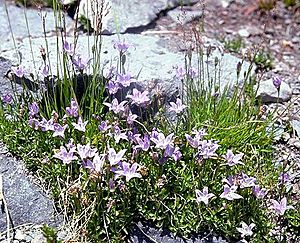Wilkins' bellflower facts for kids
Quick facts for kids Wilkins' bellflower |
|
|---|---|
 |
|
| Scientific classification | |
| Genus: |
Campanula
|
| Species: |
wilkinsiana
|
Campanula wilkinsiana is a special kind of bellflower often called Wilkins' bellflower. It's a rare plant found only in California. This means it is endemic to California, growing naturally nowhere else in the world. It lives in mountain areas, like the Klamath Mountains and Cascade Range. You might also find it in the northern parts of the High Sierra.
Contents
What is Wilkins' Bellflower?
This plant is a perennial herb. This means it lives for more than two years. It grows from a thin rhizome, which is like an underground stem. The plant sends up a stem that can stand straight or lean. This stem can grow up to about 30 centimeters (about 12 inches) long.
How It Grows
Wilkins' bellflower is known for forming large groups. Many individual plants can grow close together, creating dense colonies. This helps them spread and cover an area.
What It Looks Like
The leaves of this bellflower are thin and have small teeth along their edges. They are usually between 1 and 2 centimeters (about 0.4 to 0.8 inches) long.
The flowers are very pretty. They are bright blue to a deep purple color. Each flower is shaped like a funnel and is just over a centimeter long. Inside the flower, you can see the stigma, which is blue and sticks out from the flower's opening.
How Wilkins' Bellflower Was Discovered
This unique species was first collected by a person named Lewanna Wilkins. The plant was later named in her honor, recognizing her discovery.

